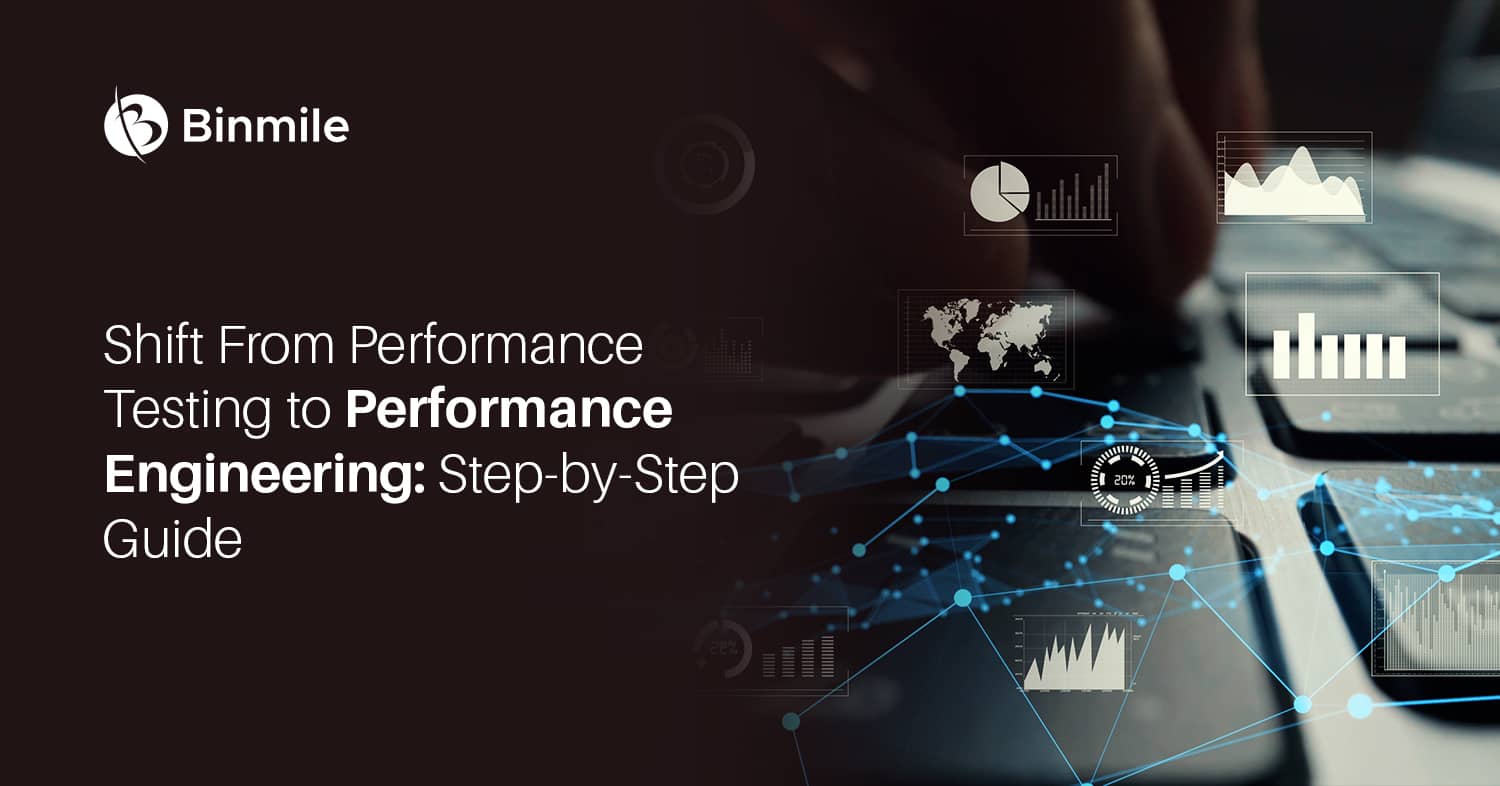- benefits of performance engineering
- how to switch from testing to development
- Performance Engineering
- performance engineering services
- performance testing to performance engineering
- performance testing vs performance engineering
- what is performance engineering
- what is performance engineering in software testing
At a time when one performance issue in your app costs millions annually, prioritizing the best testing is the only way ahead. Many organizations rely heavily on performance testing. Unlike other QA practices, its main focus isn’t on detecting bugs in code. But on ensuring the user has a comfortable interaction with the app despite other issues like load time. In addition, it allows performance issues to be discovered late, giving limited time to fix them. But not with performance engineering. It’s a relatively new concept but has been quite a popular testing approach in software development services.
Software performance engineering focuses on performance from the start of product development via continuous performance assessment and improvement processes. The performance of an app or its success depends greatly on how it performs. From the loading time, and UX design to the effect it has on the device, all aspects must satisfy the user’s needs. With performance engineering testing businesses can catch performance-related issues early and fix them at a relatively low cost. There are other benefits of performance engineering testing too, so let’s understand them. In this blog, we’ll discuss how performance engineering works, and how it can help your business.
5 Steps to Move from Performance Testing to Performance Engineering

Transitioning from performance testing to performance engineering is a strategic move that can significantly improve product quality and overall user experience. Here are 5 essential steps to make this transition successful and achieve better product quality and user experience:
1. Assess Current Testing Processes and Tools
Businesses need to assess the present performance testing procedures and solutions to identify the gaps and flaws in their existing testing approach. Doing so not only helps you understand your testing purpose such as whether testing is only about identifying issues, or about a proactive approach to enhance performance throughout the development lifecycle. Additionally, you can set the objectives more clearly if you know where you currently stand.
2. Set Clear Performance Objectives
It’s essential to define specific performance metrics or goals for your applications or software to work at their full potential. These metrics can range from response time, and scalability to resource utilization. Once you have well-defined objectives provides a clear roadmap for your performance engineering efforts. In addition, you must ensure that there’s a balance between your business goals and user expectations before you set up these metrics.
3. Scalability Planning and Budgeting
Performance engineering might reduce your development cost but it still needs significant budget and resources. Organizations need to develop a robust scalability and budgeting strategy. This is to make sure that your software and organization can handle increased workloads. Thus your budget and system must be prepared to accommodate accordingly to the growth and demand fluctuations.
4. Use Automation and DevOps Practices
Being a modern testing approach, nothing can be done traditionally, so automation is key for effective, quicker, and accurate software performance engineering testing. Wheel, DevOps practices encourage collaboration, communication, and feedback among different teams involved in the SDLC. Thus, by integrating both automation and DevOps practices into performance engineering, businesses can ensure that their software meets the expected performance requirements and delivers a better user experience.
5. Implement Continuous Performance Monitoring
Businesses must implement continuous monitoring to track the performance of their applications in real time. Thereby, they must utilize advanced monitoring tools and techniques to proactively identify performance bottlenecks. Conducting regular analysis of the data and insights collected enables them to refine strategy. Thus, empowering them to create high-performance software that meets current demands and is also future-ready.
*Bonus Point
6. Embrace a Holistic Approach
Performance engineering is not just about identifying bottlenecks or issues, it goes beyond that. It creates a culture of performance awareness, collaboration, and knowledge sharing. It’s a performance-first approach that encompasses the entire development cycle from the initial design phase to production. Therefore, it actively collaborates with developers, testers, and stakeholders to implement the right performance metrics and ensure they’re being followed at every stage of development.
Ready to test your website, application, or API for performance? Get in touch today!
Performance Testing vs Performance Engineering: An Overview
There’s not much difference between performance testing vs performance engineering debate. Since both are two sides of the same coin. Both performance engineering and performance testing adopt best practices to ensure the application is built for high performance and enhances the user’s experience. However, there’s one aspect that differentiates one from the other. It is how much importance is given to the timing of the identification of the performance-related issues in the app– at what stage of the SDLC.
While performance testing aims to maintain an app’s responsiveness and load-handling capacity. It checks how a system is going to perform under production load and detects issues that might arise later in the development cycle. On the other hand, performance engineering ensures the app is optimized and follows the performance metrics, thus discovering potential issues early in the development cycle.
From design to development to QA, performance engineering is involved in all phases of the development cycle. It’s more of a continuous process that runs parallel with all phases of software development. Thus, driving more efficiency and accuracy to the app testing, bringing an optimized product, and subsequently boosting the user’s experience.
Why Performance Testing isn’t Better than Performance Engineering?
Performance testing is crucial to the software testing process but it gets outshined by performance engineering due to the following reasons:
- Performance testing works in a controlled test environment. Thus, at times it doesn’t fully replicate real-world conditions, making identification of issues challenging.
- Gives insights into only specific metrics like poor response time. Thus, overlooking some other performance metrics such as code quality, security, or compatibility issues.
- Running large-scale or comprehensive performance tests can be expensive and resource-intensive, especially for smaller organizations with limited resources.
- It is conducted at a later phase of SDLC, thus it doesn’t give early detection and limits rapid changes. At times, late discovery occurs when it’s more costly to resolve the issues.
How to Switch from Performance Testing to Performance Engineering: Top Reasons
- Performance engineering reduces the need to rework and refactor the application, thus lowering system and hardware costs.
- Let businesses be flexible and iterative by adopting other development approaches such as CI/CD lifecycle, agile, or DevOps.
- It allows early detection of product performance issues, ensuring stable and reliant UX.
- Leveraging performance engineering businesses can have a faster time to market with all the performance-related issues within the development phase.
- It promotes continuous improvement of user experience with seamless and smooth app performance.
Shifting Gears: Go From Performance Testing To Performance Engineering
Testing is an integral part of the software development cycle. It helps you deliver high-quality digital products, ensures a smooth user experience, and also reduces the cost of development. No matter which process you use, if it’s done systematically, your SDLC team and end-users will appreciate the fast detection and prevention of performance issues. As discussed in the blog, both performance testing and performance engineering bring great advantages to your software quality testing services.
It must be noted that selecting the right tool or approach for your testing in development depends a lot on your business requirements. You can go with either performance testing or performance engineering or maybe both. However, with the changing nature of software development and user expectations, testers must switch from traditional performance testing services to advanced performance engineering models.
So, if you are also looking for the best ways to switch from performance testing to performance engineering, our QA experts can be of help. The right QA team software testing experts can improve the performance of your digital product with this modern engineering approach like a pro!
Frequently Asked Questions
Performance Engineering is a comprehensive approach to optimize and enhance the performance of software applications and systems. It involves analyzing, designing, and implementing solutions to meet performance requirements effectively. This process ensures that an application performs efficiently, meeting user expectations and organizational goals.
- Performance Engineering Overview
- Performance Engineering is a holistic approach to optimize and enhance software application performance.
- It encompasses analysis, design, and implementation of solutions for efficient system performance.
- The goal is to meet user expectations and organizational objectives regarding application performance.
- Engage our services early in the Software Development Lifecycle (SDLC) to identify and address performance issues during design and development.
- Continuous monitoring and optimization ensure sustained efficiency, making our services valuable throughout the application’s lifecycle.
- Consider our services prior to major releases or updates to guarantee a smooth and flawless user experience.
- Performance Engineering Services encompass a broader spectrum, proactively optimizing performance throughout development.
- Performance Testing, a subset, focuses on assessing responsiveness and stability, typically after issues have occurred.
- Integrating both ensures a comprehensive approach to managing and optimizing application performance.











